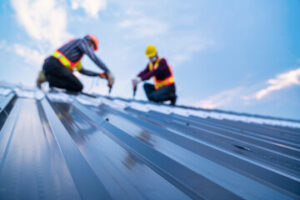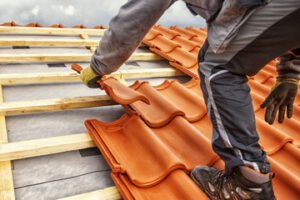A full Roof Replacement Erie PA is often more cost-effective than repeated repairs. A new roof can also be more energy-efficient, saving you money over time on your home’s heating and cooling costs.

During a roof replacement, workers clear out the attic and remove old shingles and metal flashing. They may also replace the roof deck, which is usually plywood or oriented strand board (OSB).
The roof is one of the most important structural elements of your home or rental property. It protects your belongings, prevents ice dams and water leaks, and improves curb appeal. As such, it’s critical to replace an old or damaged roof as soon as possible to avoid costly repairs and potential disasters. A new roof will also increase the value of your home or rental property and may even qualify for tax deductions.
The cost of a roof replacement varies widely depending on the materials and the size of your home. It can cost as little as $10,000 for a single-family home, or as much as $25,000 for a large multi-family building. In general, the larger the roof, the more expensive it will be. The type of roofing material used will also affect the cost, with asphalt shingles being the most affordable option. Premium roofing materials, like metal and slate, are often more expensive.
Aside from the type of roofing material, the number of layers and complexity of the roof also influences the cost. A complex roof with a steep slope, multiple levels, and an intricate underlayment system will be more expensive than a simple shingle roof. The cost of removing and disposing of the old roof and any necessary structural repairs will also add to the total cost.
The shingles that are chosen will have the biggest impact on the overall price of the roof. Shingle costs are usually quoted on a per-square foot basis, and the price range can be substantial, from basic three-tab shingles to 30- or 50-year premium architectural shingles.
Another factor that will influence the cost is the location of your house or rental property. Some areas are more prone to weather extremes, which will add to the cost of the roof. Finally, the local building code and permitting requirements will also add to the cost.
As a general rule, any improvement that increases the value of your property and extends its lifespan is eligible for a tax deduction. Consequently, it’s important to keep track of your expenses and consult with a qualified tax professional before committing to any major construction project.
Materials
The material used in roof replacement is an important factor that affects the overall cost of the project. There are many roofing materials to choose from, each with its own benefits and drawbacks. The choice of material should be made after considering your budget and desired lifespan of the roof. Additionally, it is vital to consider the material’s ability to withstand local weather conditions. Choosing a durable and long-lasting material will help to protect your home from water damage, moss, mildew, and other issues.
The type of shingle and other roofing materials you choose will also impact the cost of your roof replacement. The most popular options include asphalt shingles, wood shingles, clay and slate tiles, and metal roofing. Each has its own unique advantages and can provide superior protection to your home.
Choosing the right roofing materials can also increase the value of your property. A fresh new roof can attract potential buyers and make your home more appealing on the market. Additionally, a high-quality roof can improve your energy efficiency by reflecting solar radiant heat and helping to reduce cooling costs.
It is also a good idea to look for a roof that offers a warranty. Some manufacturers offer extended warranties that cover the entire roofing system. These warranties may also be transferable to a new owner of the home.
If your roof is nearing the end of its lifespan or you are experiencing multiple leaks, it may be time to consider a roof replacement. It is usually more cost-effective to replace the entire roof rather than attempt to repair individual leaks. Ultimately, it is important to consult with a professional roofing company to determine whether a roof replacement is necessary or if repairs are sufficient.
The cost of a new roof will depend on the material chosen and the size of your roof. Generally, the steeper the pitch of your roof and the more features such as chimneys or skylights there are, the more expensive your replacement will be. It is also essential to consider the impact of your choice of roofing material on home appraisal values and the resale value.
Installation
A good roofing contractor will know local installation codes and be familiar with all the paperwork involved. A roof replacement is a major project, and it requires the right kind of attention to detail.
First, the existing roof is removed. This process is called a tear-off and typically involves stripping the entire roofing system to expose the deck. This allows the roofer to inspect for rot, water damage, or structural problems that may need to be addressed. It also ensures that the new roofing materials will be installed over a strong and stable base.
Roofing professionals will remove the old shingles, underlayment, and flashing to reveal the sheathing and rafters beneath. The sheathing and rafters will then be prepped for the new roofing material, and any issues that need to be addressed will be corrected at this time. The new shingles and underlayment are then installed. This is a great opportunity to add ventilation holes and vents for increased attic insulation. The roofer will also install any necessary flashing around chimneys, wood stove pipes, certain vents, and along hip roofs.
If your roofing company is replacing a shingle roof, they will likely require an EZ re-roof permit if your town or city requires them. However, if you are replacing a different kind of roof or making significant structural changes, your contractor might need a full building permit.
This is a good idea in any case, as it protects you from liability and ensures that your work complies with local building codes. If a building inspector notices that you are working without a permit, he or she can order all work to stop until the proper permits are obtained.
While the work is being done, make sure that there is a 15-foot clearance around your house to prevent people and animals from getting hurt by falling shingles or debris. This is especially important if your roof is being torn off and replaced. Also, keep pets indoors as hammers and noise can disturb them and they might step on stray nails. If this is not possible, try to arrange a friend’s or pet boarding service during the work.
Warranty
Roof replacement is one of the most expensive home improvement projects that homeowners can undertake. With costs ranging from $5,000 on the low end to tens of thousands of dollars, many homeowners are looking for peace of mind and want to make sure that their new roof is covered by a warranty. However, not all warranties are created equal. Some may only cover the materials while others offer much more comprehensive coverage. The type of warranty that is best for you will depend on your specific needs and the cost of your new roof.
The three primary types of roof warranties available are standard material warranties, extended material warranties and workmanship warranties. A standard material warranty covers the manufacturing defects in the roofing materials for a specified number of years. Extended manufacturer warranties last longer than standard warranties (on average 50 years) and also include coverage for the installation of the roof. These warranties are typically only offered to those who work with a certified roofing contractor and follow their specific installation requirements.
Workmanship warranties typically only cover labor and related material costs to repair a defective roof. Enhanced warranty plans like the Platinum Owens Corning Warranty provide additional coverage including labor and materials for repairs on the roof as well as the interior of the house. These warranties can cover up to 100% of the cost of repairing a defect or damage caused by the installer.
Most manufacturers require that any roof system be properly installed and maintained to maintain the validity of their warranties. This includes having the roof inspected prior to and after installation by an authorized applicator. In addition, a manufacturer will not cover a claim if the homeowner uses an unapproved roofing product or fails to have the manufacturer’s approved flashings installed.
Another factor to consider when choosing a warranty is whether or not it is pro-rated. A pro-rated warranty reduces the amount of coverage you receive as the roof ages. For example, a 20 year pro-rated Owens Corning warranty would only pay for 80% of the cost of a repair in the first 10 years and then drop to 60% in year 11. Lastly, a manufacturers’ warranty will only be valid if it is registered within a specified time frame after the installation of your new roof.
